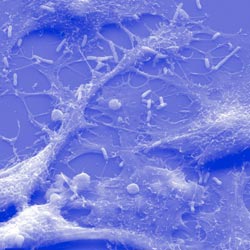Key pathological mechanism found in plague bacterium

Yersinia viewed under electron microscope<br>
In the 14th century, the Black Death claimed the lives of one third of the population of Europe. Even though the bacterium Yersinia pestis, which causes the disease, is regarded as eradicated in Europe, the World Health Organization is still reporting epidemics in Africa, Asia, and America. Bacteria in the Yersinia family can also lead to severe gastrointestinal diseases and diarrheas.
A key question that originated in research done in the 1950s is how calcium can play a critical role in the ability of Yersinia to cause disease. This long-lived issue has now been resolved by an interdisciplinary research team at Umeå University who are revealing the molecular mechanism underlying the importance of calcium.
“It was previously known that calcium inhibits an important step during the infection process. We have now identified a specific protein called YscU, which binds calcium, and we believe that this is an important part of the calcium effect,” says Hans Wolf-Watz, a senior professor at the Department of Molecular Biology.
Together with Magnus Wolf-Watz, an assistant professor at the Department of Chemistry, he has shown that the breakdown of the protein YscU is a necessary step in the infection process.
“With NMR experiments, we have been able, on the one hand, to study the details surrounding this degradation and, on the other hand, to identify which part of YscU binds to calcium,” says Magnus Wolf-Watz.
Nuclear magnetic resonance spectroscopy is a method used by researchers to determine the structure and composition of molecules. At the joint NMR Center at the Biological Chemistry Center, a new high-field 850 MHz instrument was inaugurated a week ago.
“This new instrument will provide opportunities for exciting new discoveries in our research field and in other fields, and the resource is available to scientists at other Swedish higher-education institutions,” says Magnus Wolf-Watz.
The research findings are published in the journal PLOS ONE.
For more information please contact:
Magnus Wolf-Watz, assistant professor, Department of Chemistry, Biological Chemistry Center, Umeå University, E-mail: Magnus.wolf-watz@chem.umu.se
Phone: +46 (0)90-786 76 90
Hans Wolf-Watz, professor, Department of Molecular Biology and the Laboratory for Molecular Infection Medicine Sweden, MIMS, Umeå University
E-mail: hans.wolf-watz@molbiol.umu.se, Phone: +46 (0)90 785 25 30
Original publication:
Stefan Frost, Oanh Ho, Frédéric H. Login, Christoph F. Weise, Hans Wolf-Watz & Magnus Wolf-Watz (2012) ”Autoproteolysis and Intramolecular dissociation of Yersinia YscU precedes secretion of its C-terminal polypeptide YscUCC”, PLOS ONE, The Public Library of Science ONE
Media Contact
All latest news from the category: Life Sciences and Chemistry
Articles and reports from the Life Sciences and chemistry area deal with applied and basic research into modern biology, chemistry and human medicine.
Valuable information can be found on a range of life sciences fields including bacteriology, biochemistry, bionics, bioinformatics, biophysics, biotechnology, genetics, geobotany, human biology, marine biology, microbiology, molecular biology, cellular biology, zoology, bioinorganic chemistry, microchemistry and environmental chemistry.
Newest articles

Properties of new materials for microchips
… can now be measured well. Reseachers of Delft University of Technology demonstrated measuring performance properties of ultrathin silicon membranes. Making ever smaller and more powerful chips requires new ultrathin…

Floating solar’s potential
… to support sustainable development by addressing climate, water, and energy goals holistically. A new study published this week in Nature Energy raises the potential for floating solar photovoltaics (FPV)…

Skyrmions move at record speeds
… a step towards the computing of the future. An international research team led by scientists from the CNRS1 has discovered that the magnetic nanobubbles2 known as skyrmions can be…





















